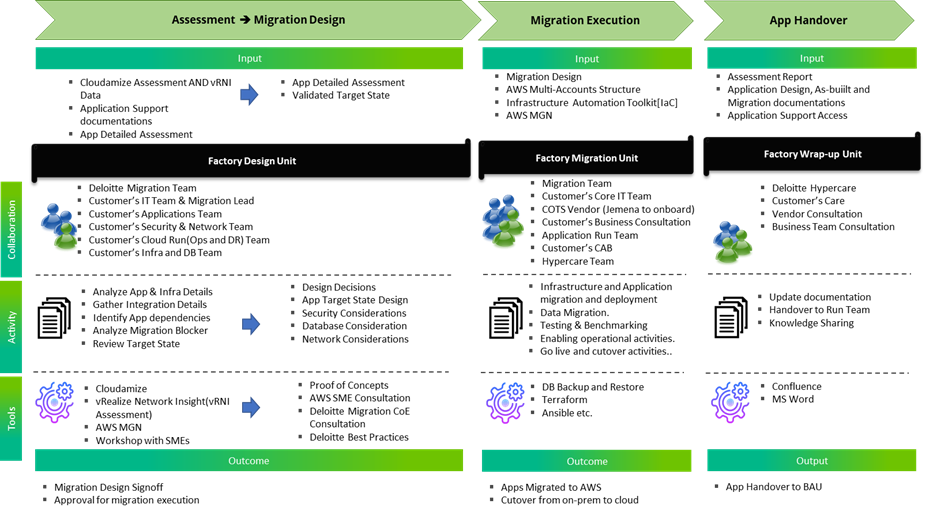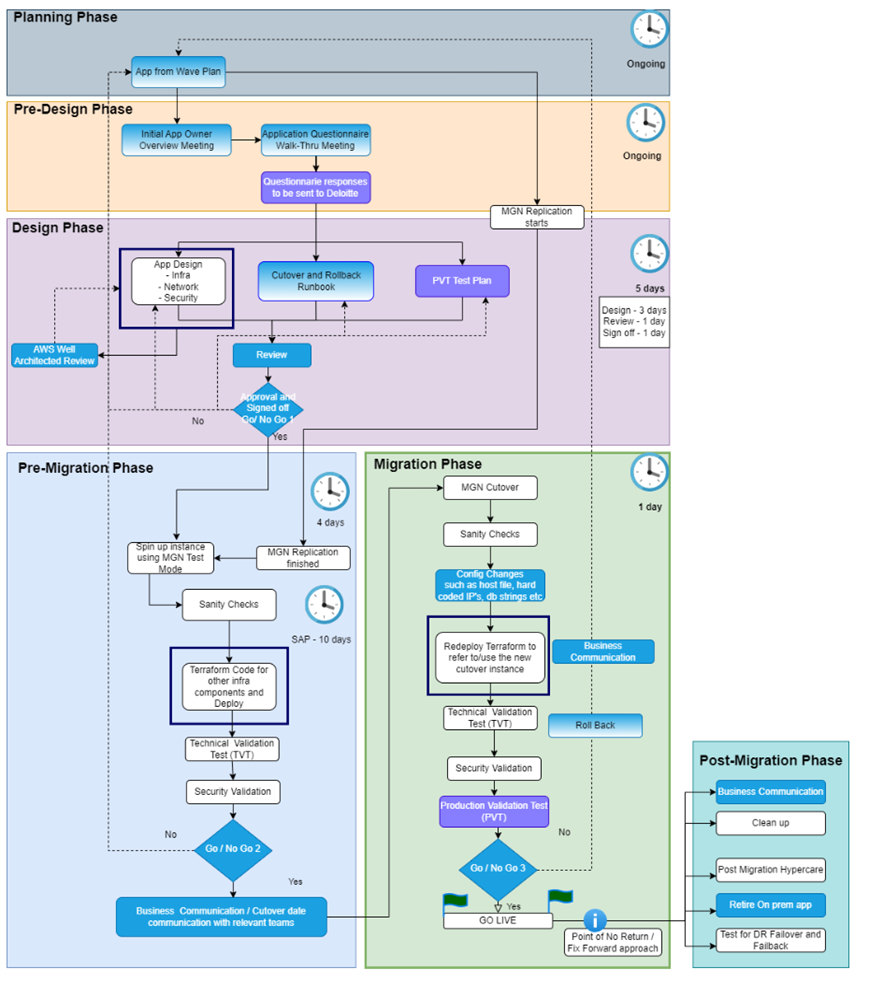“Cloud Migration Factory increases the velocity of migration and helps provide discovery & planning guidelines with architectural best practices, automated tools & templates, collaboration with migration experts & different subject matter experts, with complete governance & reporting around all the different activities”
Introduction
In order realise the transformative power of Cloud technologies, it’s just imperative to invest in research and innovation to lead the change. Over the years, companies have made significant innovations to automate the manufacturing processes to minimise the wastage in terms of labour, errors and raw materials while maximising the efficiency, quality, and the output. The “Factory” level delivery is usually achieved through long “assembly lines” where each workstation completes a particular task before passing the output to the next stage. Having learned from the experience in spearheading Cloud transformation journeys of customers across various industry domains, we developed a full spectrum of industrialised frameworks, tools, and capabilities to accelerate the Cloud adoption and transformational exercises.
The Cloud Migration Factory brings its own expertise, accelerators, and frameworks to establish from scratch OR augment using customers’ foundational elements. It enhances and de-risks Cloud migration experience, thereby achieving customer’s digital ambition.
The Customer Context
The Cloud Migration Factory model was established to achieve DC Exit ambition of a Utilities customer but can be seamlessly configured for application in other industries too. The customer is a Large Energy Company in Australia which owns and operates a diverse portfolio of energy assets across the east coast of Australia. Company’s network of transmission and distribution assets brings energy to the lives of millions of Australians. The company is on a digital transformation journey to become more data-driven and customer-centric. Given that the workloads in question enabled critical utility services, along with fulfilling Regulatory and Market obligations, it was paramount that the Migration Factory delivers sure-shot and first-time success, consistency, agility, and water-tight governance.
How did we go about setting up the Factory?
In the beginning, the Cloud Migration journey for this major utility provider was started with all the usual phases of the projects, such as
- Cloud Migration Readiness Assessment
- Build a Business Case
- Cloud Migration Blueprint
- Cloud Pre-Migration Readiness and Cloud Foundations setup
The Migration Blueprint delivered a comprehensive Migration wave plan which was fed into the factory so that it can start executing a repeatable, efficient, flexible process that can provide design, Infrastructure provisioning, migration, testing, rollbacks, training and cutovers with monitoring and reporting. The design works were primarily conducted onsite to be powered with appropriate SME interface. The actual migration was achieved through Cloud Migration factory with teams operating in onsite and offshore model to drive value for money.
The Migration factory was broadly classified into three assembly lines. (1) Re-Host and Re-Platform (2) File-share and SFTP Migrations and (3) Disaster Recovery Planning and Testing. The pre-built assembly lines are a combination of infrastructure, application/file-share, networking, and database technologies which are pre-configured to deploy the workloads securely onto the Cloud.
The factory operated on the principle of scalable squads across assembly lines determined by the load and the time factor for migration. The assembly lines, supplemented with their own technical run book/procedural documents, managed the seamless migration, and used repeatable scripts and migration tools to standardise the process and enable maximum utilisation of automation. The team of Cloud engineers, cross trained in multiple technologies, performed various functions involved in the migration using the pre-defined processes.

The following steps were commonly followed as part of the Re-Host, Re-platform Migration Factory
- Based on the inputs from Assessment/Design services team, the Terraform infrastructure build was triggered/tweaked.
- Design Decision made by Assessment/Design services team were validated OR calibrated by quick PoC (Proof of Concept)
- The input to Migration Execution, in terms of detailed migration treatment plan and move groups, came from the assessment/design services team.
- For each move group, Migration Execution team used the appropriately detailed Run-book and established patterns
- Migration Execution engaged key IT and business users to conduct elaborate verification and validation activities (system testing, integration testing, performance testing).
- Orchestrated the cut-over, enabled performing business verification testing (BVT) and go-live whilst embedding learnings, captured via facilitated Post implementation Review (PIR), into the Factory processes
Migration Factory – Impact and Value
The industrialised migration execution with its own pre-configured assembly lines, patterns and scalable pods helped utilities customer achieve:
- Efficiency: Cloud Migration Factory Accelerator allowed specialised PODs and teams to work on similar patterns of migration, which increased throughput. With a customised repository of migration scripts, migration of workloads to Cloud was automated
- Transparency / Traceability: Cloud Migration Factory Accelerator governed the progress with streamlined migration workbench and costs traced via the water-tight Cost Modelling approach
- Consistency: Cloud Migration Factory, equipped with continually-calibrated Assembly lines, tools, templates and processes allowed for consistently and repeatably great experience across IT and business teams
Migration factory delivers a proven, step by step process for technology migrations through different units that includes the following:
- Discovery & Planning
- Design and Proof of Concept (PoC)
- Build, Remediation and Assurance
- Deployment & Cut-over
- Business Verification and Sign-off

The Factory model, in addition, enabled identification of optimisation and modernisation opportunities for the business.
Conclusion:
The Cloud Migration Factory helps provide discovery & planning guidelines with architectural best practices, automated tools & templates, collaboration with migration experts & different subject matter experts; with complete governance & reporting around all the different activities performed within each unit.
Cloud Migration Factory framework focuses on
- People – Dedicated team of migration experts with flexible onshore/offshore model
- Process – Proven methodology & re-usable tools/automation templates
- Technology – Configuration compliant, consistent and first-time-right builds with automated technology enablement
The factory teams are self-sufficient and include five to six cross-functional roles operating across different geographies. They include Analysts, Network SMEs, Migration Architects, Security & Testing SMEs along with DevOps professionals.
Enterprise application portfolio usually consists of many repeated patterns that can be optimised by a factory approach. Cloud Migration Factory increases the speed of the migration, with multiple factory-unit teams executing in parallel. With this agile delivery model, it is important to create a continually evolving and elaborated migration wave plan which can be based on current workloads and information generated during the assessment and planning phase. It can be continually optimised with the backlog of applications that enable us to re-prioritise work-loads, and keep Factory running, if the schedule was impacted for any reason.

